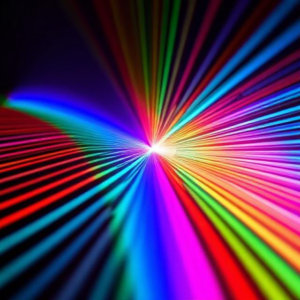Diffraction Gratings
What is a Diffraction Grating?
A diffraction grating is an optical device that splits light into its component colors or wavelengths. It works by having a large number of closely spaced parallel lines or grooves on a surface (usually made of glass or metal). These grooves cause light to diffract (spread out) and form specific patterns, allowing us to study the different wavelengths of light.

How Does It Work?
- Light Passing Through: When light passes through or reflects off the surface of the grating, each groove acts like a tiny barrier that causes the light to bend.
- Interference: Light waves that pass through different grooves interfere with each other. The interference can be constructive (where light waves align and amplify) or destructive (where light waves cancel out).
- Constructive Interference: The grating produces bright spots (called diffraction maxima) at certain angles, where the light waves from different grooves interfere constructively.
- Order of Diffraction: These bright spots occur at specific angles, and they correspond to different orders of diffraction (like the first order, second order, etc.). The angle at which light is diffracted depends on the wavelength (or color) of the light and the spacing between the grooves of the grating.
The Diffraction Grating Equation
To find the angles at which constructive interference happens (i.e., where the bright spots appear), we use the diffraction grating equation:
Where:
is the distance between adjacent grooves (also called the grating spacing).
is the angle at which light is diffracted.
is the order of diffraction (1 for the first order, 2 for the second order, etc.).
is the wavelength of the light.
Example:
If we shine white light through a diffraction grating, each color (wavelength) will diffract at a different angle. This is how a diffraction grating can produce a rainbow spectrum when white light is passed through it, similar to how a prism works.
Resolving Power of a Diffraction Grating
What is Resolving Power?
The resolving power of a diffraction grating is its ability to distinguish between two closely spaced wavelengths (or colors) of light. In other words, it’s a measure of how finely the grating can separate light into its component wavelengths.
- Higher Resolving Power: A grating with high resolving power can distinguish between two very similar wavelengths of light.
- Lower Resolving Power: A grating with low resolving power cannot resolve closely spaced wavelengths, and they appear as a single color.
How is Resolving Power Defined?
The resolving power
of a diffraction grating is given by the formula:
Where:
is the wavelength of light.
is the smallest difference between two wavelengths that the grating can distinguish (this is the resolving power).
is the order of diffraction.
is the total number of lines or grooves on the grating.
The larger the number of grooves
, the better the grating’s resolving power.
Why is Resolving Power Important?
- High resolving power allows us to clearly separate and measure closely spaced lines in spectra, which is important in fields like spectroscopy.
- It is used to study the chemical composition of distant stars or identify elements in a sample based on their light emission spectra.
How Diffraction Gratings and Resolving Power are Used:
- Spectroscopy: Diffraction gratings are widely used in spectrometers to analyze the spectra of light from different sources (like stars, gases, and chemicals). By measuring the angles of the diffracted light, we can identify the wavelengths (or colors) and study the composition of the source.
- Chemical Analysis: In flame tests or atomic emission spectroscopy, diffraction gratings help identify elements based on the characteristic wavelengths of light they emit.
- Astronomy: Gratings are used in telescopes to resolve the spectral lines of stars, allowing astronomers to determine things like temperature, composition, and motion.
In Summary:
- Diffraction Gratings: These are devices with many closely spaced lines or grooves that cause light to spread out into its component wavelengths. They are used to produce a spectrum of light, much like a prism.
- Resolving Power: This refers to the ability of a diffraction grating to distinguish between two very close wavelengths of light. A higher number of grooves on the grating improves its resolving power, allowing it to separate similar colors more effectively.
Together, diffraction gratings and their resolving power play a crucial role in fields like spectroscopy, astronomy, and chemical analysis, helping scientists and researchers study light in great detail.











